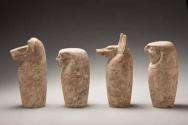Canopic Jar
Date: about 600 BCE
Dimensions:
11 1/2 in. (29.2 cm)
Medium: limestone with paint
Place of Origin: Egypt
Classification: Sculpture
Credit Line: Gift of Edward Drummond Libbey
Object number: 1906.16
Label Text:As part of the Egyptians’ preservation and mummification of the body after death, they removed the moist, soft-tissue organs to prevent them from decaying. Traditionally, mortuary workers removed and dried the lungs, liver, stomach, and intestines, placing them in vessels known as canopic jars, which were entrusted to gods known as the Four Sons of Horus. The jars often had lids in the forms of their heads. The one with the baboon head (Hapi) protected the lungs, the jar with the human head (Imsety) contained the liver, the jar with the jackal head (Dua-mutef) held the stomach, while the hawk-headed jar (Qebeh-senu-ef) protected the intestines.
By about 1000 BCE, organs were no longer preserved in jars, but mummified and reinserted in the body. The tradition for jars was so strong, however, that they continued to be placed in the tomb, even though empty. Many, like the solid ones displayed here, were mere symbols of traditional vessels.
By about 1000 BCE, organs were no longer preserved in jars, but mummified and reinserted in the body. The tradition for jars was so strong, however, that they continued to be placed in the tomb, even though empty. Many, like the solid ones displayed here, were mere symbols of traditional vessels.
DescriptionJackal head shaped. Solid, dummy jar, with incised line to suggest differentiation of cover and jar.
On view
In Collection(s)





